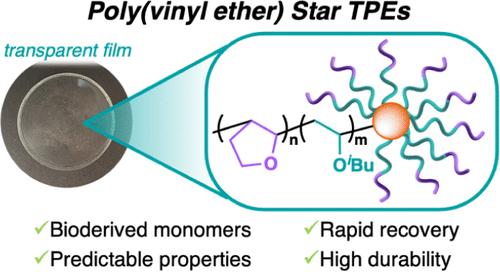Poly(vinyl ether) Star Copolymers as Bioderived Thermoplastic Elastomers
IF 5.2
1区 化学
Q1 POLYMER SCIENCE
引用次数: 0
Abstract
Poly(vinyl ether) thermoplastic elastomers (TPEs) have potential as sustainable alternatives to petroleum-based TPEs, as the monomers can be bioderived, the materials are reprocessable for extended lifetime, and the polymers are degradable at the end of their life. To expand upon poly(vinyl ether) TPEs, a star architecture was utilized with poly(2,3-dihydrofuran) as the high glass transition temperature (Tg) block and poly(isobutyl vinyl ether) as the low Tg block. After purification, the physical properties were characterized to identify structure–property relationships, with specific focus on the composition and molar mass of the arms, allowing for targeted design within the physical property space. Small-angle X-ray scattering was utilized to understand the connection between the material’s morphology and the observed structure–property trends. Notably, after initial analysis, the star TPEs were reprocessed to give similar materials to the original samples and retested under cyclic stress, demonstrating the recyclability of the materials. From these experiments, we demonstrate the versatility and durability of poly(vinyl ether) star copolymers as sustainable alternatives to traditional TPEs.

作为生物衍生热塑性弹性体的聚乙烯醚星形共聚物
聚乙烯醇(乙烯醚)热塑性弹性体(tpe)具有替代石油基tpe的可持续发展潜力,因为其单体可以生物衍生,材料可再加工以延长使用寿命,并且聚合物在使用寿命结束时可降解。为了扩展聚(乙烯基醚)TPEs,采用了星形结构,聚(2,3-二氢呋喃)作为高玻璃化转变温度(Tg)块,聚(异丁基乙烯基醚)作为低Tg块。纯化后,对物理性质进行表征,以确定结构-性质关系,特别关注臂的组成和摩尔质量,从而在物理性质空间内进行有针对性的设计。利用小角度x射线散射来了解材料的形态与观察到的结构-性能趋势之间的联系。值得注意的是,经过初步分析,星型tpe被重新处理,得到与原始样品相似的材料,并在循环应力下重新测试,证明了材料的可回收性。从这些实验中,我们证明了聚乙烯醇星形共聚物作为传统tpe的可持续替代品的多功能性和耐久性。
本文章由计算机程序翻译,如有差异,请以英文原文为准。
求助全文
约1分钟内获得全文
求助全文
来源期刊

Macromolecules
工程技术-高分子科学
CiteScore
9.30
自引率
16.40%
发文量
942
审稿时长
2 months
期刊介绍:
Macromolecules publishes original, fundamental, and impactful research on all aspects of polymer science. Topics of interest include synthesis (e.g., controlled polymerizations, polymerization catalysis, post polymerization modification, new monomer structures and polymer architectures, and polymerization mechanisms/kinetics analysis); phase behavior, thermodynamics, dynamic, and ordering/disordering phenomena (e.g., self-assembly, gelation, crystallization, solution/melt/solid-state characteristics); structure and properties (e.g., mechanical and rheological properties, surface/interfacial characteristics, electronic and transport properties); new state of the art characterization (e.g., spectroscopy, scattering, microscopy, rheology), simulation (e.g., Monte Carlo, molecular dynamics, multi-scale/coarse-grained modeling), and theoretical methods. Renewable/sustainable polymers, polymer networks, responsive polymers, electro-, magneto- and opto-active macromolecules, inorganic polymers, charge-transporting polymers (ion-containing, semiconducting, and conducting), nanostructured polymers, and polymer composites are also of interest. Typical papers published in Macromolecules showcase important and innovative concepts, experimental methods/observations, and theoretical/computational approaches that demonstrate a fundamental advance in the understanding of polymers.
 求助内容:
求助内容: 应助结果提醒方式:
应助结果提醒方式:


